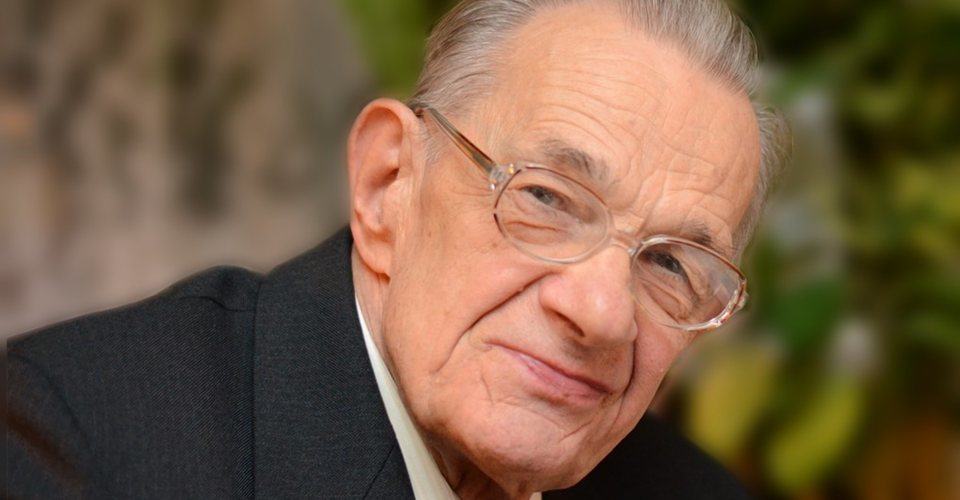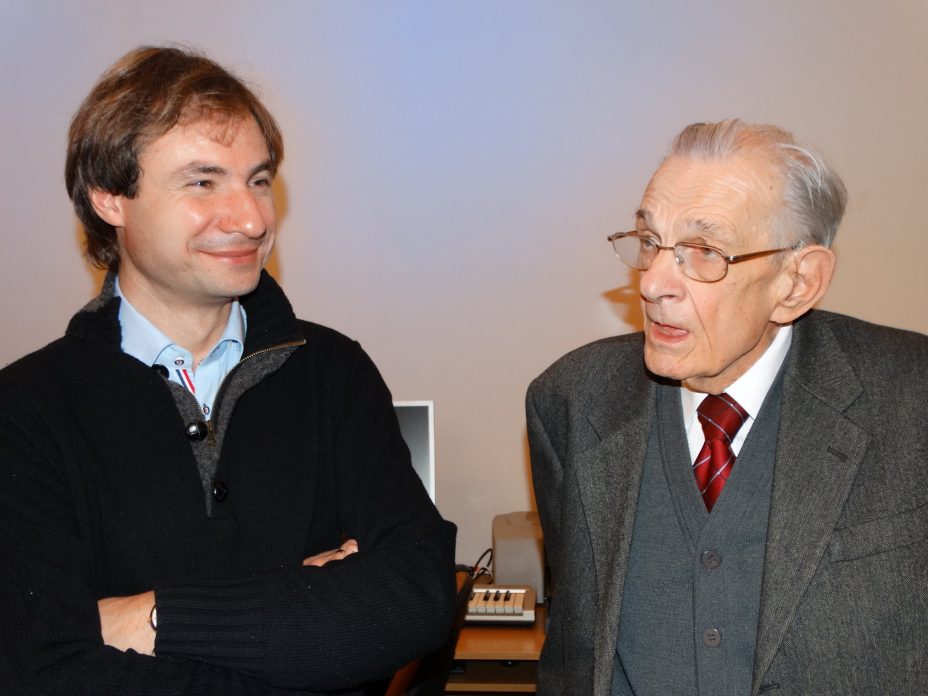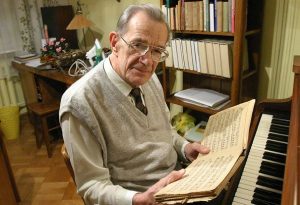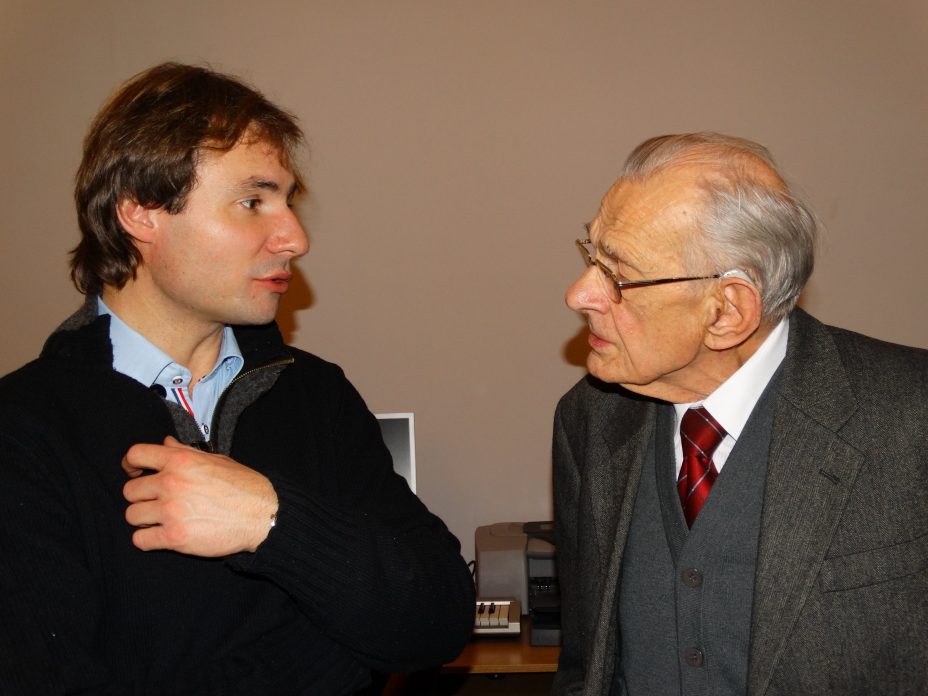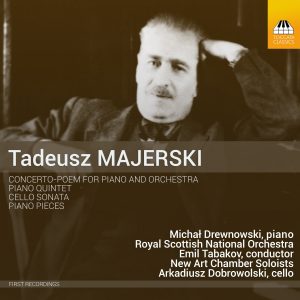 A December release from Toccata Classics (TOCC0344) presents the first-ever recording of works by the Polish composer Tadeusz Majerski (1888–1963), whose music incorporates elements of Szymanowski’s impressionism, Schoenberg’s dodecaphony and Karłowicz’s late Romanticism. Probably the last living link with Majerski is the composer, pianist and teacher Andrzej Nikodemowicz, born in Lwów in 1925. At the Lwów Conservatoire Nikodemowicz studied composition with Adam Sołtys (graduating in 1950) and piano with Majerski (1954). Nikodemowicz himself was a lecturer there from 1951 to 1967, and from then to 1973 as an assistant professor, teaching composition, theory and piano. During that period he was persecuted for his religious beliefs and finally made redundant. In the 1970s all his radio recordings were destroyed. In 1980 he moved to Lublin and worked as a professor at the Maria Curie-Skłodowska University and the Catholic University of Lublin; there he again taught composition, theory and piano. With the return of democracy came recognition: he has been the President of Polish Composers’ Association since 1989 and is the recipient of a number of prizes. A substantial part of his output is religious music, including some forty cantatas. He has also written seven piano concertos, a violin concerto, two symphonies and piano and chamber pieces. His compositions have been performed in Poland and abroad.
A December release from Toccata Classics (TOCC0344) presents the first-ever recording of works by the Polish composer Tadeusz Majerski (1888–1963), whose music incorporates elements of Szymanowski’s impressionism, Schoenberg’s dodecaphony and Karłowicz’s late Romanticism. Probably the last living link with Majerski is the composer, pianist and teacher Andrzej Nikodemowicz, born in Lwów in 1925. At the Lwów Conservatoire Nikodemowicz studied composition with Adam Sołtys (graduating in 1950) and piano with Majerski (1954). Nikodemowicz himself was a lecturer there from 1951 to 1967, and from then to 1973 as an assistant professor, teaching composition, theory and piano. During that period he was persecuted for his religious beliefs and finally made redundant. In the 1970s all his radio recordings were destroyed. In 1980 he moved to Lublin and worked as a professor at the Maria Curie-Skłodowska University and the Catholic University of Lublin; there he again taught composition, theory and piano. With the return of democracy came recognition: he has been the President of Polish Composers’ Association since 1989 and is the recipient of a number of prizes. A substantial part of his output is religious music, including some forty cantatas. He has also written seven piano concertos, a violin concerto, two symphonies and piano and chamber pieces. His compositions have been performed in Poland and abroad.
On 21 November 2013 the pianist Michał Drewnowski, who is the primus motor in the rediscovery of Majerski and his music, interviewed Professor Nikodemowicz at his home in Lublin as part of his research. He began by asking him what kind of pianist Majerski was:
I never heard him play. I became his student after he had given up his concert career. It was in the early ’40s. At that time Tadeusz Majerski was just over 50 and was not a concert pianist any more. I do not know why. I was told that he had played many concerts, both as a soloist and chamber musician at home and abroad. His international tours included Vienna and other places. He performed with his brother, Jan Majerski, who was a soloist at the Paris Opera, and Ada Janowska, a renowned opera singer. Once when I was leaving his class, I heard him playing Chopin’s Polonaise in A flat major. It was an amazing, simply outstanding performance.
Majerski was forced to stop his concert career for a long time due to a serious hand injury. It allowed him to meditate on the art of piano-playing. It must have also influenced his way of teaching.
Yes, in his youth he went through a traumatic period. It was not a common injury. It should be classified as a hand condition which resulted from an incorrect playing technique. For a while he was not able to perform. His personal trauma led him to explore the methodology of piano-playing. It resulted in a few theoretical works.1 I consider them splendid works, still significant today. […]
Was Majerski one of the most distinguished professors of the Lwów Conservatoire at that time?
You could not be more wrong. He was not popular at the Conservatoire. He was brushed aside. He was so to speak‚ ‘a suspicious character’.
Why?
There were many reasons, which operated on many levels. Majerski had his heart in the right place, but had an appearance of the old-fashioned gentleman – the elegance of pre-war culture, always extremely smart. His manners and ways evidently stood out. He was not unpleasant in his conduct; on the contrary, he was always very well-mannered. For the Soviets, for those people who arrived from the east, he was a foreign element, the phenomenon of ‘non-adaptation’: he did not adapt to the new system2, as his former student Henryk Mozer3 recalls. In this respect he was unchangeable. He did not speak Ukrainian, never learned the language. In principle, one could get the impression – though I am of a different opinion – that he spoke bad Ukrainian on purpose. He could communicate better in Russian. I believe that it was the reason for some of the reservations about him from the very beginning.
Since he was side-tracked by the Conservatoire authorities, the most talented students were not sent to his class.…
There was a period when he was not allowed to teach piano as a main instrument. At that time, being a student of composition, I applied to be taught by him. Later more of us were allowed to join his class. He used to tell me about his students from before the war. In the inter-war period he had many talented ones, with a potential to make international careers as pianists. Unfortunately, most of them were Jewish and none of them survived the horror of the German occupation4. After the war he did not have a single very talented pianist.
Were there any great pianists teaching at the Lwów Conservatoire at that time?
There was not a single renowned pianist there. One of the most outstanding pedagogues was Professor Edelman who was the head of piano faculty5. I remember him as a very decent man. He did not make a career as a pianist and focused mainly on teaching. […]
Did Majerski make his students play his own compositions?
I never encountered that. I played many of his pieces, but it happened after I finished my studies and without him knowing about it.
How did he get on with his students?
He had a tremendous sense of humour and liked socialising. It was out of the question for him to keep a distance from his students or to treat them formally. We had long discussions with him and he never looked at his watch. We often had our classes at his flat in Modrzejewska Street and that helped created a very friendly atmosphere.
Anyone researching Polish dodecaphony comes across only the name of Koffler. He corresponded with Arnold Schoenberg around 1930, and by that time Majerski had already composed some dodecaphonic pieces. Does that mean that Koffler and Majerski were composing at the same time? If that’s true, it’s difficult to say who was first.
That seems to be the case. They were both professors at the Lwów Conservatoire. I have always strongly emphasised that often-neglected fact that in the ’30s Tadeusz Majerski together with Józef Koffler were the first composers of dodecaphony in Poland. Majerski and Koffler were special friends on artistic and professional grounds. Koffler was closer to Schoenberg, whereas Majerski had a slightly different approach to the new technique. From the very beginning he rebelled against it. Since he did not like all its rules, he treated them loosely.
I call it expressive dodecaphony.…
He never treated music purely intellectually. He invested a wide range of feelings and emotions in it. For him it was out of question for experiment to dominate over expression. So later he often returned to traditional means of expression.
As a renowned composer, how do you evaluate Majerski’s compositions?
I esteem them very highly. His compositions have a very original style, which is hard to define. Alas, I did not have an opportunity to get acquainted with his most important works, to mention only his Symphonic Études for orchestra, which he considered very important. The compositions which I have played and heard are outstanding. I treasure his Piano Quintet, though it is not a dodecaphonic composition, and a number of piano miniatures, including the most important ones, written in the period when he was interested in dodecaphony. I also think about Sonata for Cello and Piano…. I read somewhere that it was based on the Suite for Cello and Piano, but these pieces have little in common. It is true, although I do not remember it in detail, that he quoted a part of the Suite in his Sonata, but finally he took it out. It is quite typical for his œuvre to mix pieces in his cycle and change titles. Another recollection: when I was writing my piece Expression he liked the title so much that he used it for one of his earlier compositions, but only temporarily.
Was his Piano Quintet popular in those days?
Yes, the Piano Quintet is a marvellous composition and was very popular. I remember that it was recorded [in the 1950s] and the students used to go the ‘sound studio’ many times to listen to it! It is an excellently written piece. Each instrument has an important part there.
I agree with you, but the last variation is not conventional, very difficult to interpret.…
Right. First of all, it was very difficult technically. I remember his commentary on this variation. The Quintet was dedicated to Mieczysław Karłowicz who died during the carnival6. Majerski wanted the waltz to convey the long and loud entertainments of the carnival. The final, stormy succession of chords symbolises the avalanche which caused Karłowicz’s unexpected death.
As a performer of the Cello Sonata and the Piano Quintet, I am aware of their short forms; indeed, almost all the works subscribe to this pattern. Majerski avoids composing pieces with an elaborate form. Do you consider it a deficiency?
As a composer, I do not discern any deficiencies in his pieces. Listening to his compositions, one does not get the impression that they are too short. Their emotional saturation is so intense that their duration is satisfactory. […]
Was composition the major element in Majerski’s musical life?
In his youth he focused on playing the piano. Many a time he recalled unhappily that it was irrational to play the piano instead of composing. He regretted having spent so much time at the piano, not over sheets of music. When I first met him in 1946, he was mostly composing. I remember that when he was working on the piano concerto, he talked about it all the time; his whole life revolved around it. Only concerto and concerto…
It is instructive that all his major pieces were composed in 1928–38. Do you think that the true explanation of Majerski’s late start as a composer was his passion for playing the piano?
Yes, I think so. In his youth he composed a little, but those pieces were not particularly significant. At that time he practised a lot, widened his repertoire and gave concerts. It is only in the early ’30s that his creative tendency can be clearly observed. At that time he composed his most important pieces.
Was Majerski mistreated as a pianist or as a composer during the period of Soviet domination?
What I observed was that Majerski was brushed aside as a composer. When I met him, he was not a concert pianist any more. He concentrated on composing and teaching, and so there was not any ground for discriminating against him as a pianist. It was like this: in 1948 Andrey Zhdanov’s famous decree on socialist realism was announced7. It allowed the Communist Party to interfere with the work of artists, simply to manipulate it. It was a total disaster. Majerski was categorised as a formalist, which resulted in endless difficulties and troubles. And Majerski, who was always open to new tendencies, was very good material for punishment. Local Ukrainian composers were completely parochial, and Majerski was the opposite. He always looked forward and was all for innovation and development. Moreover, he was considered anti-Ukrainian. He neither could speak nor write Ukrainian. After the war there were not so many Poles in Lwów any more. Most Poles left the city in 1945–46. It also put him on the musical margin.
Sołtys and Majerski were the only ones who stayed in Lwów.
Mieczysław Sołtys died much earlier, but his son Adam stayed in Lwów.8 He was much more communicative than Majerski, and on top of it he was a good diplomat. He had no choice. In order to carry his activities in Lwów he had to be a good diplomat. His Ukrainian and Russian were very poor, too, but unlike Majerski he never demonstrated it. When Majerski spoke, it was difficult to resist the feeling that he spoke it very badly on purpose. And Sołtys learned how to speak this Polish-Ukrainian-Russian language. For many years he animated musical life in Lwów in good and bad times.9 After all, for many years he was Director of the Polish Music Society. All artistic groups and institutions belonged to it – Conservatoire, orchestra, music ensembles.
I have to admit that reading about music life in Lwów in those days I get truly fascinated. You just devour the information! What concerts, what soloists and conductors there were – Ravel, Shostakovich, Szymanowski….
They were the days! Karol Szymanowski, Bela Bartók, Dmitri Shostakovich, Sergei Prokofiev used to visit Lwów. When Szymanowski came to Lwów, it was Sołtys who conducted the orchestra. It was the first performance of the Symphony No. 3 with large symphony orchestra, choir and solo voice.10 After the great success of the concert Adam Sołtys and Karol Szymanowski drank brotherhood!
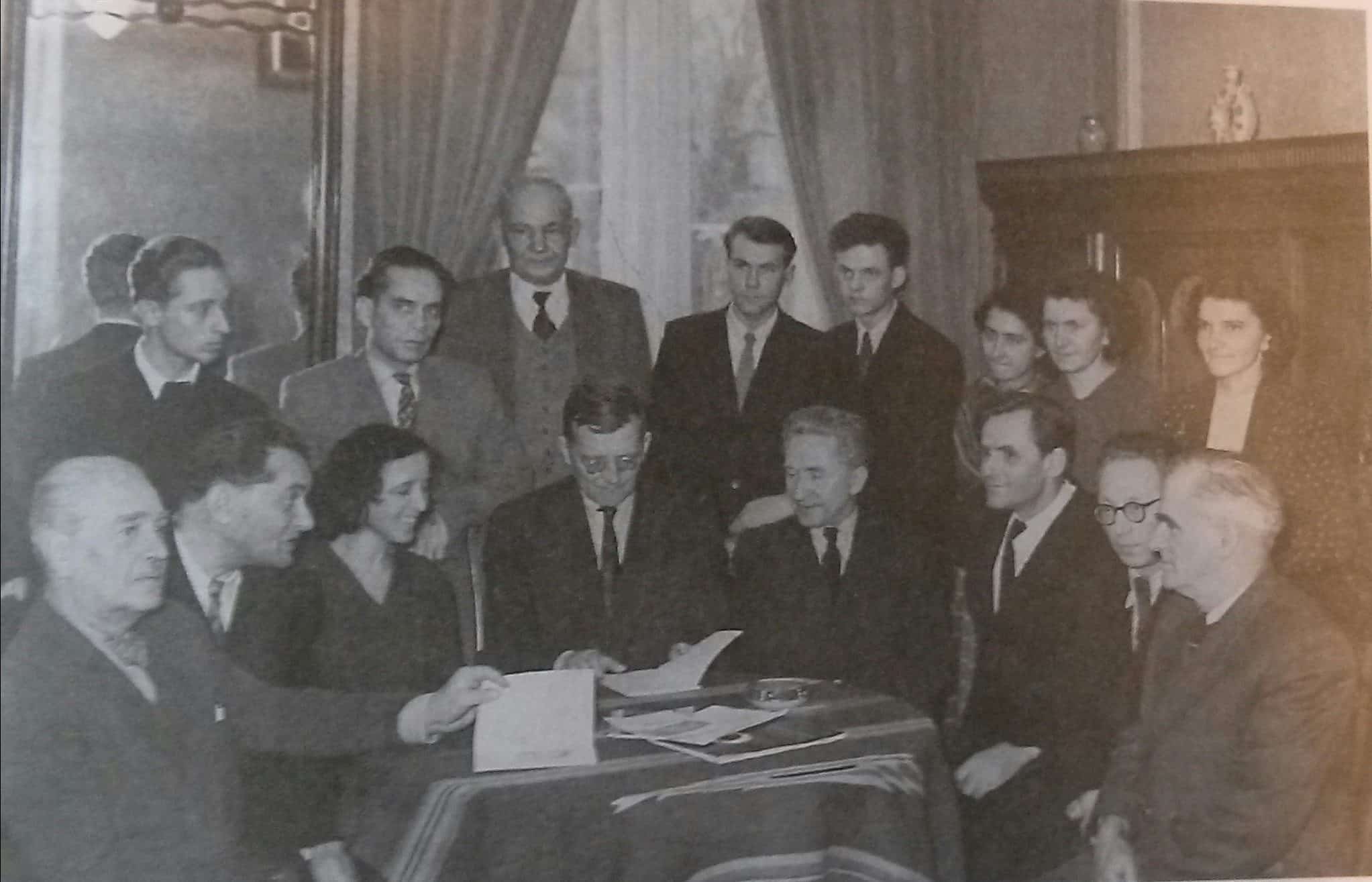
Shostakovich (centre) in Lviv around 1958, on the occasion of a concert of his music: at a meeting at the headquarters of the USSR Union of Composers, Majerski is seated far left, and on the far right is the composer Adam Sołtys (1890–1968), who, like Majerski, was born and died in Lviv.
Were Majerski’s pieces performed after the war?
It was very rare during the Soviet times. I remember performances of the Cello Sonata, Piano Concerto and a recital of a Neuhaus student whose name I cannot recall. Majerski asked her to play several miniatures. Apart from that, I do not remember anybody playing his compositions. But this concerns Lwów. In Basel the famous German conductor Hermann Scherchen conducted his Symphonic Études. Professor often mentioned it, since it made him feel very proud and happy.
Majerski wrote also a violin concerto.
It was one of his last pieces, composed in 1962 and he had Kaja Kanczowska in mind. She was his close relative, then a very young and extremely talented student of Professor Eugenia Umińska.11 Majerski never finished this concerto and did not orchestrate it. It existed just as a version for violin and piano. This concerto was performed only once in Warsaw in 1988 at the conference of musicologists.12 Kaja Danczowska played the violin and Eugeniusz Knapik13 the piano. I hope that one day this concerto will be professionally orchestrated and will find its place in the violin repertoire.
Did Majerski talk about his compositions? Which of them did he value most?
I do not recall such conversations, but my general impression is that he was pleased with them. His favourite compositions were the piano concerto and Symphonic Études.
I am the only person in Poland who has performed this concerto. I spent much time on the manuscript of this piece with the copyist, since the piece was not published. It was a tremendous amount of work. It often felt more like reconstructing than copying. I might find one thing in the score, something else in the piano part and still another version in the orchestra parts. What was the source of this confusion?
Well, Professor was a slightly… chaotic person. He was writing this concerto for almost ten years. He introduced many changes in it, starting with the title. In the beginning it was called Piano Concerto and later Concerto-Poem for piano and orchestra. The premiere has its own story. The first performance was cancelled as the orchestral parts given to the musicians turned out to be useless. Professor had his heart in the right place, which was manifested, among other things, by him giving a substantial part of his income to a number of old and lonely people. He kept his own requirements to a minimum. And so he had no money to pay a copyist and decided to copy the orchestral parts himself. He had never done it before and therefore made a tremendous number of mistakes – counting empty bars wrongly, for example. There was such a mess during the first rehearsal that the concert had to be postponed! After a while the orchestral parts were copied by a professional and the concert could finally take place. The solo piano part was performed by the late Mihail Brandorf.14 The orchestra was conducted by Yuriy Luciv, who still lives in Lwów.15 In spite of all that Soviet regime, it was a good time for music…
Why didn’t he leave Lwów?
Majerski had a very complicated family situation – it was incomprehensible to me. Professor was married. I remember that somebody from his wife’s family in Poland died and she was so upset that she decided to move to Poland. I do not know if Majerski intended to join her later or not. There was another complication. His brother-in-law, with whom the Majerskis shared the flat [i.e., Dezyderiusz Danczowski], was poisoned by gas and paralysed as a result. In the beginning he managed on his own, but gradually his condition started to deteriorate and he could not move without assistance. He simply stopped walking. It was another reason why Majerski could not leave Lwów: for many years he looked after that seriously ill, paralysed man with the utmost care, while his wife lived in Poland. She died there. Her death affected him tremendously. I still believe that he had a chance to leave Lwów even though he never talked about it openly. Out of politeness I never enquired. […]
What kind of person was Majerski?
He was always in a good mood, full of jokes. He never complained about anything. His vitality, optimism, joy and engagement were infectious. With hindsight, I can see better how important he was in my life and how much I owe him. Majerski was a good, intimate family friend. He used to visit us at home when my wife was still in Lwów. We have several photographs of all of us. It seems that Professor enjoyed visiting us and he liked me as his student. We belonged to the same Polish circles which included also some musician friends. We used to meet and go out together.
Did you give all Majerski’s manuscripts to the National Library in Warsaw? Are there any pieces that are not there?
When I left Lwów in 1980, I took all Majerski’s compositions with me. I gave them to the library and kept only some duplicates. I tried to get people from the music world interested in his œuvre. I am happy that you appeared and I am very grateful to you.
It is my pleasure. I feel proud that, thanks to working on Tadeusz Majerski’s music, I had a chance to make your acquaintance. I consider it a great honour. Thank you for your recollections, which have brought the figure of Tadeusz Majerski much closer to me.
1. Majerski’s writings are currently unpublished.
2. The ‘new system’ was Soviet Communism: before the Second World War Lwów had been the third-largest city in Poland; now, as Lviv, it found itself part of the Ukrainian Soviet Socialist Republic, and subject to an intensive and brutal policy of Russification – effectively repeating the circumstances which had obtained from late 1939 under the Molotov-Ribbentrop Pact, which divided Poland between Germany and Russia.
3. Henryk Mozer (1930–2009) was a student of Majerski in Lwów. After graduating from the Conservatoire in 1955, he was a theatre director, graduating again, from the Zelwerowicz School of Theatre in Warsaw, in 1972. His memoirs exist as an article in Ruch Muzychy (‘Memories of Majerski’), No. 20, 1974) and an unpublished manuscript.
4. Before the war Lwów had had the third-largest Jewish population of any Polish city. After the German invasion of the Soviet Union in 1941, a series of pogroms was followed by the establishment of the Lwów Ghetto, the 120,000 inhabitants of which were either transported to extermination camps (mainly Bełżec, to the north-west of the city) or murdered locally.
5. That is, Alexander Lazarevich Edelman (dates unknown). The pianist Sergei Edelmann is his son.
6. A superfically misleading statement. Karłowicz was killed in an avalanche in the Tatra Mountains, on 8 February 1909. The carnival period that forms part of Christian tradition falls on or after the feast of Epiphany and culminates on Shrove Tuesday (‘Mardi Gras’), usually in early February.
7. Placed in charge of Soviet cultural policy by Stalin in 1946, Zhdanov focussed his attention on writers to begin with. His decree on music, issued on 10 February 1948, attacking ‘formalism’ in music, was followed up by a conference in April at which many of the leading Soviet composers – among them Shostakovich, Prokofiev and Khachaturian – were condemned.
8. Mieczysław Sołtys (1863–1929) was a composer, conductor and teacher who spent all his life in Lwów, apart from studying composition in Vienna and in Paris (with Saint-Saëns) and counterpoint and organ (with Gigout). His output includes five operas, three oratorios, two symphonies, two symphonic poems, piano concerto, choruses, songs and music for piano and organ. Adam Sołtys (1890–1963), likewise composer, conductor and teacher, studied composition with his father and with Robert Kahn and Georg Schumann in Berlin, where he also took courses in musicology. He joined the staff of the Lwów Conservatoire on his return home and was appointed director in 1929, on the death of his father, and was active also as critic and broadcaster. His own music includes two symphonies and a number of other orchestral pieces (including a Concerto for Orchestra), chamber and piano music and songs. His best-known student is Stanisław Skrowaczewski.
9. As conductor of the Lwów Philharmonic from 1933 Adam Sołtys led performances of many major works, among them Bach oratorios, Beethoven’s Ninth Symphony, Brahms’ Deutsches Requiem, Brucker’s Te Deum, Honegger’s Le roi David, Mahler’s Das Lied von der Erde, Stravinsky’s Syphony of Psalms and much else, not least the music of his Polish contemporaries.
10. Szymanowski’s Symphony No. 3, Op. 27, The Song of the Night (1914–16), sets a poem by the thirteenth-century Persian mystic Jalāl Ud-Dīn Rūmī in a Polish translation by Tadeusz Miciński. The concert to which Nikodemowicz refers took place on 2 March 1928, when the solo soprano was Szymanowski’s sister Stanisława Korwin-Szymanowska (an earlier performance in London, conducted by Albert Coates on 24 October 1921, has been orchestral only).
11. A student of Ševčík and Enescu, Eugenia Umińska (1910–80) was already a major figure on the pre-war musical landscape of Poland (she had a duo with Szymanowski, for example) and, escaping capture after taking part in the Warsaw Uprising, she went on to teach at the Academy of Music in Kraków and was briefly (1964–66) its Rector.
12. At the National Musicology Conference in Warsaw, held on 30 April 1988, Andrzej Nikodemowicz gave a lecture to mark the centenary of Majerski’s birth and the 25th anniversary of his death. Majerski was born Polish and never changed his citizenship; he is therefore recognised as a Polish composer.
13. Knapik (b. 1951), now a professor at the Katowice Academy of Music, numbers Górecki and Messaien among his teachers; in the 1970s he was one of the ‘Stalowa Wola’ group of composers who protested again intolerant modernism and embraced tonal, even late-Romantic, idioms in their music. His works range from the symphonic to the miniature; the most substantial are the operatic trilogy The Minds of Helena Troubleyn (1987–96) and the opera Moby Dick (2010).
14. Mihail Semenovich Brandorf (1911–68), who promulgated Majerski’s music in the 1950s.
15. He is head of the conducting department of the National Academy of Music in Lviv. He is also known by the Polish version of his name, Jurij Łuciw.
